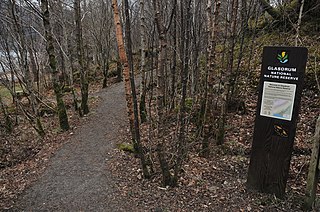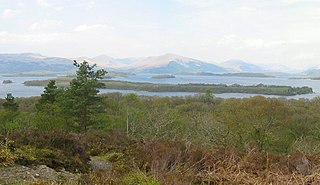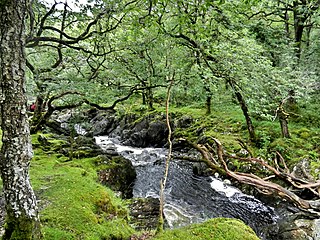Evolutionary history
| | This section is empty. You can help by adding to it. (August 2014) |
Celtic Rainforest is a colloquial term which refers to the temperate rainforest of Ireland and Great Britain. These woodlands are also variously referred to as Atlantic rainforest, Upland Oakwoods, Atlantic Oakwoods or Western Oakwoods. Today, the Celtic Rainforest exists as small fragments of the temperate rainforest that once covered much of Ireland and the west coast of Great Britain. The majority of these fragments occur on steep-sided slopes above rivers and lakes which have avoided clearance and intensive grazing pressure. There are notable examples in Ireland especially along its western coast, including the Beara Rainforest in West Cork, [1] the Great Forest of Aughty in Clare and Galway, Oldhead Wood in Mayo and Ardnamona Wood and Glenveagh in Donegal. [2] In Scotland, rainforest exists on the islands and shores of Loch Maree, Loch Sunart, Loch Lomond, and one of the best preserved sites on the remote Taynish Peninsula in Argyll. In Wales, they occur on steep-sided riverine gorges in Snowdonia and Mid Wales. In England, there are examples in the Lake District (Borrowdale Woods), and steep-sided riverine and estuarine valleys in South West England, including the Fowey valley in Cornwall, and the valley of the river Dart which flows off Dartmoor, and has rainfall in excess of 2 metres per year. [3]
Small annual temperature variation, high humidity, and high levels of annual precipitation makes Celtic Rainforest an important habitat for numerous common and rare species of mosses, liverworts, and lichens. [4] [5] [6] [7] The Scottish Natural History Scientific Advisory Committee writes, "the whole area is a lichenologists’ Mecca". [4] There is an exceptional number of epiphytic plants (plants growing on or hanging from trees without being parasitic). [4] The ground is covered with a deep blanketing of mosses and liverworts, which rise up the trunks of the trees onto the horizontal branches and up into the canopy. [4]
| | This section is empty. You can help by adding to it. (August 2014) |
| | This section is empty. You can help by adding to it. (August 2014) |
The Celtic Rainforest is dominated by sessile oak (Quercus petraea), downy birch (Betula pubescens) and European ash (Fraxinus excelsior). Other trees include pedunculate oaks, hazel, elm, cherry, and various willows. [4]
| | This section is empty. You can help by adding to it. (August 2014) |
| | This section is empty. You can help by adding to it. (August 2014) |
Rare lichen communities are found using the mosses as a substrate, and add a wealth of colour to the understory. [4] Lichens of genera Pannaria , Parmeliella , and Degelia add a lead-grey color; [4] lichens of the genus Sticta are very dark; the fruit of jelly lichens (Biatora sphaeroides) are pink; those of Dimerella lutea are bright yellow; and those of dog lichen in the genus Peltigera make chestnut coloured fruits in the shape of shields. [4] The weight of the lichens using mosses as a substrate gradually causes the moss carpeting to peel off the trees, where heaps of rare lichens can be found on the ground. [4] Lungworts are lichens in the genus Lobaria , four species of which can grow up to 30 centimetres or more across.
The more alkaline bark of ash and hazel favour the growth of specklebelly lichens ( Pseudocyphellaria spp.). [4] In the grazed birch woodland on higher ground, the bark has a high acidity due to leaching by the high rainfall. This area is dominated by silvery-grey leafy species of lichens that grow directly on the tree bark, not on mosses. [4]
| | This section is empty. You can help by adding to it. (August 2014) |
Historically, these woodlands were coppiced, [4] with the wood being used for charcoal, tanning, and bobbin-making; these practices ended in the mid-1800s. Today, the remaining fragments of Celtic rainforest are protected for conservation and research. [4] Since the 20th century, conservation efforts have resulted in the protection and management of many of these woodlands, to address problems such as invasive Rhododendron , excessive grazing from sheep and deer, and non-native plantation trees. [8]

Temperate rainforests are rainforests with coniferous or broadleaf forests that occur in the temperate zone and receive heavy rain.

Killarney National Park, near the town of Killarney, County Kerry, was the first national park in Ireland, created when the Muckross Estate was donated to the Irish Free State in 1932. The park has since been substantially expanded and encompasses over 102.89 km2 of diverse ecology, including the Lakes of Killarney, oak and yew woodlands of international importance, and mountain peaks. It has the only red deer herd on mainland Ireland and the most extensive covering of native forest remaining in Ireland. The park is of high ecological value because of the quality, diversity, and extensiveness of many of its habitats and the wide variety of species that they accommodate, some of which are rare. The park was designated a UNESCO Biosphere Reserve in 1981. The park forms part of a Special Area of Conservation and a Special Protection Area.

The Caledonian Forest is the ancient (old-growth) temperate forest of Scotland. The forest today is a reduced-extent version of the pre-human-settlement forest, existing in several dozen remnant areas.

The Scandinavian coastal conifer forests or Norwegian coastal conifer forest is a Palearctic ecoregion in the temperate coniferous forests biome, located along the coast of Norway. Within it are a number of small areas with botanical features and a local climate consistent with a temperate rainforest.

Sunart is a rural district and community in the south west of Lochaber in Highland, Scotland, on the shores of Loch Sunart, and part of the civil parish of Ardnamurchan. The main village is Strontian, at the head of the loch, which is the location of Ardnamurchan High School, the local fire station, police station and other facilities.

The English Lowlands beech forests is a terrestrial ecoregion in the United Kingdom, as defined by the World Wide Fund for Nature (WWF) and the European Environment Agency (EEA). It covers 45,600 km2 (17,600 sq mi) of Southern England, approximately as far as the border with Devon and South Wales in the west, into the Severn valley in the north-west, into the East Midlands in the north, and up to the border of Norfolk in the north-east. The WWF code for this ecoregion is PA0421.

The flora of Scotland is an assemblage of native plant species including over 1,600 vascular plants, more than 1,500 lichens and nearly 1,000 bryophytes. The total number of vascular species is low by world standards but lichens and bryophytes are abundant and the latter form a population of global importance. Various populations of rare fern exist, although the impact of 19th-century collectors threatened the existence of several species. The flora is generally typical of the north-west European part of the Palearctic realm and prominent features of the Scottish flora include boreal Caledonian forest, heather moorland and coastal machair. In addition to the native species of vascular plants there are numerous non-native introductions, now believed to make up some 43% of the species in the country.

Ceunant Llennyrch National Nature Reserve is one of several woodland reserves in the Vale of Ffestiniog in Gwynedd, Wales and runs from Llyn Trawsfynydd to the River Dwyryd, near the village of Maentwrog.

Ireland is in the Atlantic European Province of the Circumboreal Region, a floristic region within the Holarctic.

Ariundle Oakwood is situated to the north of the village of Strontian in the Sunart area of the Highlands of Scotland. It is located on the western side of the glen of the Strontian River, to the south of former lead mining sites that lie further up this glen. The wood is part of the ancient Sunart Oakwood, and is a remnant of ancient oakwoods that once spanned the Atlantic coasts of Europe from Norway to Portugal. It was designated as a National Nature Reserve in 1977, and is managed primarily by NatureScot, in conjunction with Forestry and Land Scotland, who own the land surrounding the National Nature Reserve. The reserve is classified as a Category IV protected area by the International Union for Conservation of Nature, and also forms part of both a Site of Special Scientific Interest and a Special Area of Conservation.
Lower Wye Gorge is a 65-hectare (160-acre) biological and geological Site of Special Scientific Interest in Gloucestershire, notified in 1954 and renotified 1987. The site includes two Gloucestershire Wildlife Trust nature reserves being Ban-y-gor Wood and Lancaut. The Natural England citation states a revision for Lancaut inclusion.

Atlantic hazelwood is hazel dominated temperate rainforest that occurs on the hyperoceanic western fringe of Europe, in particular on the west coasts of Scotland and Ireland. It is considered to be a type of climax scrub. It occurs in exposed, coastal situations where thin soils and strong winds prevent the establishment of trees.
Minwear Wood is a Site of Special Scientific Interest in Pembrokeshire, South Wales. It has been designated as a Site of Special Scientific Interest since January 1968 in an attempt to protect its fragile biological elements including ancient woodland of sessile oak with hazel and downy birch on the upper part of the Milford Haven estuary. The wood is structurally diverse and has scarce plants and epiphytic lichens. The site has an area of 13.69 hectares and is managed by Natural Resources Wales.

Glasdrum Wood is national nature reserve (NNR) at the head of Loch Creran in Argyll and Bute on the west coast of Scotland. Managed by NatureScot, the wood is renowned for its diverse flora and fauna, including sessile oak and ash trees, mosses, liverworts and rare invertebrates, like the chequered skipper butterfly. The NNR covers an area of around 169 hectares, encompassing woodland and hillside on the lower slopes of Beinn Churlain. A carpark and 1 km-long waymarked trail are provided for visitors. Since 2004 the reserve has received approximately 2800 visitors each year.

Taynish National Nature Reserve is situated southwest of the village of Tayvallich in the council area of Argyll and Bute on the west coast of Scotland. The reserve encompasses almost all of the Taynish peninsula, which is around 5 km long and 1 km wide. The woodlands at Taynish are often described as a 'temperate rainforest', benefiting from the mild and moist climate brought about by the Gulf Stream. Taynish is owned and managed by NatureScot and was declared a national nature reserve (NNR) in 1977. The reserve was formerly also a biosphere reserve, but this status was withdrawn in 2014.

Loch Lomond National Nature Reserve (NNR) encompasses 430 hectares of land at the southeastern part of Loch Lomond in the council areas of Stirling and West Dunbartonshire, in Scotland. It covers the islands of Inchcailloch, Clairinsh, Torrinch, Creinch and Aber Isle, alongside areas of woodland and wetlands to either side of the mouth of the Endrick Water. NatureScot owns two parts of the reserve - the island of Inchcailloch and part of Gartfairn Wood - and the rest is privately owned. The reserve is managed by a partnership consisting of NatureScot, the RSPB Scotland and the Loch Lomond and The Trossachs National Park, along with the owners and tenants of the land under agreements. Within this framework NatureScot directly manage the islands of Clairinsh, Inchcailloch, Torrinch and Creinch, and land to the north of the Endrick Water. The RSPB manages the area to the south of the Endrick Water, and the national park manages visitor facilities on Inchcailloch.

Glen Nant is a glen lying to the south of Taynuilt in the Argyll and Bute council area of Scotland. An area of woodland of 339 hectares on the western side of the River Nant is designated as national nature reserve (NNR), which is owned and managed by Forestry and Land Scotland (FLS). It is an example of an Atlantic Oakwood, and is one of largest areas of upland oak woodland in north Argyll.

Dolmelynllyn Estate is an area of farmland, woodland and parkland near the village of Ganllwyd in southern Gwynedd, Wales. It is owned by the National Trust. The estate was formerly owned by William Madocks, the architect of Porthmadog. Features of the estate include ancient woodland, temperate rainforest, rare lichens and mosses, as well as archaeological features from prehistoric cists to nineteenth-century gold mines. The estate also has 46 bee boles on it, which is the highest concentration in the United Kingdom.
Alexandra "Sandy" M. Coppins is a Scottish lichenologist. She was president of the British Lichen Society from 2002 to 2004.

There are various areas of temperate rainforests in Wales, also termed a "Celtic rainforest". They are located largely in river valleys, adjacent to the sea, on Wales' western coasts, particularly in Snowdonia (Eryri), Powys and Ceredigion.